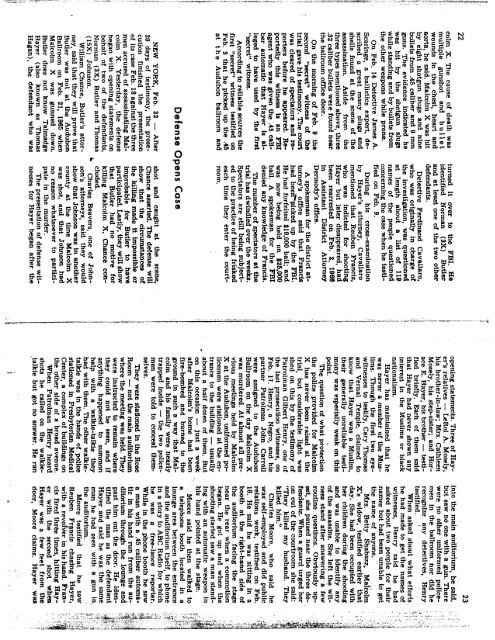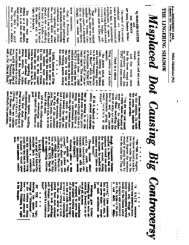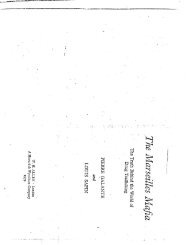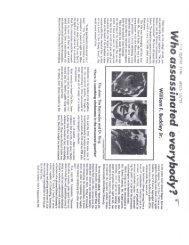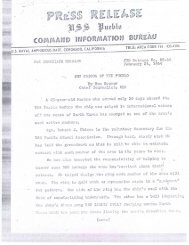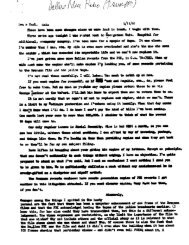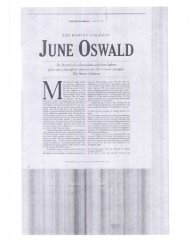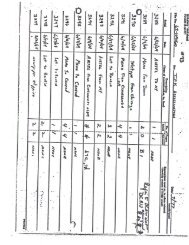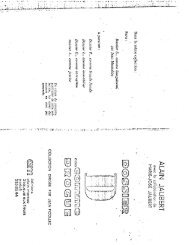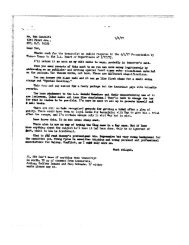THE ASSASSINATION OF MALCOLM X
THE ASSASSINATION OF MALCOLM X
THE ASSASSINATION OF MALCOLM X
You also want an ePaper? Increase the reach of your titles
YUMPU automatically turns print PDFs into web optimized ePapers that Google loves.
NEW YORK, Feb. 22 — After<br />
20 days of testimony, the prosecution<br />
finished the presentation<br />
of its case Feb. 18 against the three<br />
men accused of assassinating Malcolm<br />
X. Yesterday, the defense<br />
began with opening statements on<br />
behalf of two of the defendants,<br />
Norman (3X) Butler and Thomas<br />
(15X) Johnson.<br />
William Chance, Butler's attorney,<br />
said that they will prove that<br />
Butler was not at the Audubon<br />
Ballroom on Feb. 21, 1965 when<br />
Malcolm X was gunned down.<br />
Butler does not know Talmadge<br />
Hayer (also known as Thomas<br />
Hagan), the defendant who was<br />
shot and caught at the scene,<br />
Chance asserted. The defense will<br />
show that the circumstances of<br />
the killing made it impossible or<br />
improbable for Butler to have<br />
participated. Lastly, they will show<br />
that Butler had no motive for<br />
killing Malcolm X, Chance concluded.<br />
6. Charles Beavers, one of Johnson's<br />
attorneys, said they would<br />
show that Johnson was in another<br />
county at the time Malcolm X<br />
was shot, and that Johnson had<br />
no reason whatsoever to participate<br />
in the murder.<br />
The presentation of defense witnesses<br />
for Hayer began after the<br />
opening statements. Three of Hayer's<br />
relatives — LeRoi A. Mosely,<br />
his brother-in-law; Mrs. Cathleen<br />
Mosely, his step-sister; and Horace<br />
E. Hayer, his brother — testified<br />
briefly. Each of them said<br />
that Hayer had never shown any<br />
interest in the Muslims or black<br />
nationalism.<br />
Hayer has maintained that he<br />
was never a member of the Muslims.<br />
Though the first two eyewitnesses<br />
to testify, Cary Thomas<br />
and Vernal Temple, claimed to<br />
know that Hayer was a Muslim,<br />
their generally unreliable testimony<br />
was especially weak on this<br />
point.<br />
The question of what protection<br />
the police provided for Malcolm<br />
X has never been raised at the<br />
trial, but considerable light was<br />
shed on this by the testimony of<br />
Patrolman Gilbert Henry, one of<br />
the last prosecution witnesses, on<br />
Feb. 17. Henry, a Negro, and his<br />
partner Patrolman John Carroll<br />
were assigned to the Audubon<br />
Ballroom on the day Malcolm X<br />
was murdered. At almost all previous<br />
meetings held by Malcolm<br />
X at the Audubon, uniformed policemen<br />
were stationed at the entrance<br />
to the building — usually<br />
about a half dozen of them. But<br />
on this occasion — just a week<br />
after Malcolm's home had been<br />
fire-bombed and burned to the<br />
ground in such a way that Malcolm<br />
and his family were nearly<br />
trapped inside — the two policemen<br />
were told to conceal themselves.<br />
They were stationed in the Rose<br />
Room — not the main auditorium<br />
where the meeting was held. They<br />
were instructed to remain where<br />
they could not be seen, and if<br />
anything happened to summon<br />
help with a walkie-talkie they<br />
had with them. The other walkietalkie<br />
was in the hands of police<br />
stationed in Presbyterian Medical<br />
Center, a complex of buildings on<br />
the other side of a broad avenue.<br />
When Patrolman Henry heard<br />
shots he called on the walkietalkie<br />
but got no answer. He ran<br />
23<br />
into the main auditorium, he said,<br />
but saw no one with a gun. There<br />
were no other uniformed policemen<br />
in the ballroom nor did he<br />
recognize any detectives, Henry<br />
testified.<br />
When asked about what efforts<br />
he had made to get the names of<br />
witnesses, Henry said he had<br />
asked about two people for their<br />
names but had been unable to get<br />
the name of anyone.<br />
Mrs. Betty Shabazz, MalColm<br />
X's widow, testified earlier that<br />
day. She had been occupied with<br />
her children during the shooting<br />
and was unable to identify any<br />
of the assassins. She left the witness<br />
stand after answering a few<br />
routine questions. Obviously upset,<br />
she paused near the three defendants.<br />
When a guard urged her<br />
on out of the courtroom she said:<br />
"They killed my husband. They<br />
killed him."<br />
Charles Moore, who said he<br />
was self-employed and did public<br />
relations work, testified on Feb.<br />
18. He said he was sitting in a<br />
booth at the right-hand side of<br />
the auditorium facing the stage<br />
near the rear when a commotion<br />
began. He got up and when the<br />
shooting started saw a man standing<br />
with an automatic weapon in<br />
his hand pointed at the stage.<br />
Moore said he then walked to<br />
a telephone booth located in a<br />
lounge area between the entrance<br />
and the auditorium itself, to phone<br />
in a story to ABC Radio for which<br />
he was a free-lance reporter,<br />
While in the phone booth he saw<br />
a man with a .45 caliber automatic<br />
in his hand run from the auditorium<br />
through the lounge and<br />
past him out the door. He identified<br />
the man as the defendant<br />
Hayer and said he was the same<br />
man he had seen with a gun<br />
the auditorium.<br />
Moore testified that he saw<br />
Reuben Francis chasing Hayer,<br />
with a revolVer in his hand. Francis<br />
fired three times, hitting Hayer<br />
with the second shot when<br />
Hayer was a few feet from the<br />
door, Moore claims. Hayer was<br />
Defense Opens Case<br />
22<br />
colm X. The cause of death was<br />
multiple gunshot and bullet<br />
wounds in the chest, heart and<br />
aorta, he said. Malcolm X was hit<br />
by eight shotgun slugs and nine<br />
bullets from .45 caliber and 9 mm<br />
guns. The evidence indicated he<br />
was hit by the shotgun slugs<br />
while standing and by bullets from<br />
the other weapons while prone.<br />
On Feb. 14 Detective James A.<br />
Scaringe, a ballistics expert, described<br />
a great many slugs and<br />
shells found at the scene of the<br />
assassination. Aside from the<br />
three types mentioned above, three<br />
.32 caliber bullets were found near<br />
the ballroom office door.<br />
On the morning of Feb. 9 the<br />
second "secret" witness of the<br />
trial gave his testimony. The court<br />
was cleared of spectators and reporters<br />
before he appeared. Reportedly<br />
this witness is an FBI<br />
agent who was given the .45 caliber<br />
automatic that Hayer is alleged<br />
to have used by the first<br />
"secret" witness.<br />
According to reliable sources the<br />
first "secret" witness testified on<br />
Feb. 3 that he picked up the .45<br />
at t h e Audubon ballroom and<br />
turned it over to the FBI. He<br />
identified Norman (3X) Butler<br />
and at least one of the two other<br />
defendants.<br />
Detective Ferdinand Cavallaro,<br />
who was originally in charge of<br />
the investigation, was questioned<br />
at length about a list of 119<br />
names of the people questioned<br />
concerning the case when he testified<br />
on Feb. 9.<br />
During his cross-examination<br />
by Hayer's attorney, Cavallaro<br />
mentioned that Reuben Francis,<br />
who was indicted for shooting<br />
Hayer but later disappeared, had<br />
been rearrested on Feb. 2, 1966<br />
in Assistant District Attorney<br />
Dermody's office.<br />
A spokesman for the district attorney's<br />
office said that Francis<br />
had beefi'picked up by the FBI.<br />
He had forfeited $10,000 bail; and<br />
was now being held on $25,000<br />
bail. A spokesman for the FBI<br />
denied any knowledge of Francis.<br />
The number of spectators at the<br />
trial has dwindled over the weeks.<br />
Spectators are still being subjected<br />
to the practice of being frisked<br />
each time they enter the courtroom.


